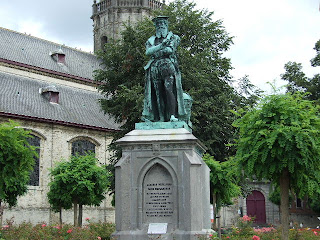Birthday Thoughts: Age
is Relative
Several years ago, a bug-eyed comedian named Dennis Wolfberg
spoke about his age. “I’m in my very late 30s,” he said. “I’m 43.”
Tomorrow, I will once again reach my very late 50s. So I’m
thinking about age today.
How do we talk about age or think about age? George Carlin
noted that when you’re young, you use half-year designations or the word “almost.” You’re “6 and a half” or “almost 7.” Not too
many people would say, “I’m 52 and a half” or “almost 53.” Well, I’m in my very
late 50s.
More on age:
Audrey and I were watching Kim Clijsters at the U.S. Open
the other night and wondered how old she was. Pulling out the trusty iPad, I
discovered that she was born in 1983. That meant that she was one year older
than our daughter Amanda. I didn’t have to think about Amanda’s age (to me she’s
always around 16 or 18 or 21, though I recognize that she is older and is quite mature for
whatever her age; she always has been). I just considered Kim Clijsters to be
practically the same age. I do that a lot: comparing the age of writers,
actresses, Internet moguls, or ballplayers to that of my children. Sometimes this
does not make me feel good about my own age, I must admit.
When I did think about Amanda’s actual age—28—I realized
that she is coincidentally the same age as our dog Tess, who turned 4 two weeks
ago. That’s 4 in dog years and 28 in relative human terms. If this seems convoluted,
so what? I’m in my very late 50s.
 |
| Amanda and Tess today |
 |
| (and Amanda in my mind) |
Reaching this age has put me in the position to celebrate
another milestone: the 50th anniversary of my Bar Mitzvah. And so I
am. Come to the Glen Rock Jewish Center next Saturday morning, and you can hear
me lead the services, chant my Haftarah, read a small amount of the Torah
portion, and even deliver a speech. And I will be using mostly the same tunes
that I used 50 years ago (they still resonate in my head). The speech is new, however. Luckily, my voice is
better than it was 50 years ago, when it had a lot of trouble deciding whether it
belonged to an alto or a baritone, or occasionally to both at the same time. But
my memory is not as good. And I have many more memories to try to hold onto.
More on age:
My mother will turn 93 in January and seems more positive
about her life than I have heard her sound in years. Our friend Til, the skier
and gardener, recently turned 80. Bob Dylan is 70 and just released a new album
in which he growls like Louis Armstrong or Tom Waits. Our biking group in Belgium
featured as many 70- and 80-year olds as 60-somethings. So there is hope even
for someone reaching his very late 50s.
I figure that this ramble should end with something
literary, so here goes:
When I Was Your Age
My uncle said, “How do you get to school?”
I said, “By bus,” and my uncle smiled.
“When I was your age,” my uncle said,
“I walked it barefoot--seven miles.”
My uncle said, “How much weight can you tote?”
I said, “One bag of grain.” my uncle laughed.
“When I was your age,” my uncle said,
“I could drive a wagon--and lift a calf.”
My uncle said, “How many fights have you had?”
I said, “Two--and both times I got whipped.”
“When I was your age,” my uncle said,
“I fought every day--and was never licked.”
My uncle said, “How old are you?”
I said, “Nine and a half,” and then
My uncle puffed out his chest and said,
“When I was your age… I was ten.”
I said, “By bus,” and my uncle smiled.
“When I was your age,” my uncle said,
“I walked it barefoot--seven miles.”
My uncle said, “How much weight can you tote?”
I said, “One bag of grain.” my uncle laughed.
“When I was your age,” my uncle said,
“I could drive a wagon--and lift a calf.”
My uncle said, “How many fights have you had?”
I said, “Two--and both times I got whipped.”
“When I was your age,” my uncle said,
“I fought every day--and was never licked.”
My uncle said, “How old are you?”
I said, “Nine and a half,” and then
My uncle puffed out his chest and said,
“When I was your age… I was ten.”
-- Shel Silverstein






























